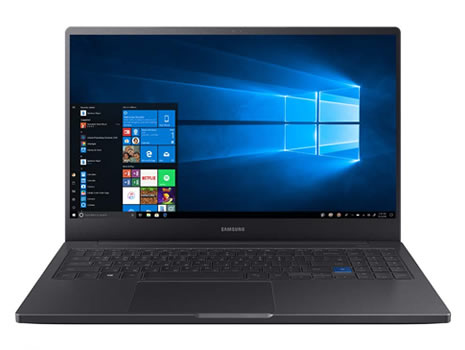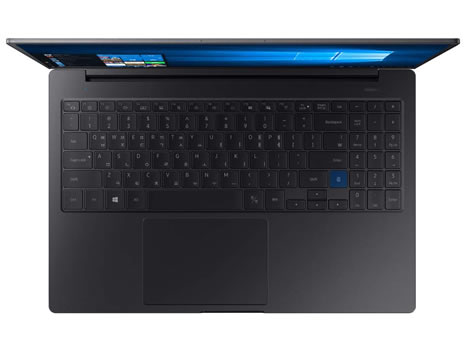The all-new Samsung Notebook 7 Force (NP760XBE-X01US) is a 15.6-inch laptop that’s in direct competition with some of the industry’s most acclaimed giants. It features an understated and minimalist design, with an almost monochrome color palette. While both looks and hardware components will definitely impress people, value for money will not. I’ll explain in detail below.
Review
Starting off, I think the Samsung Notebook 7 Force is correctly aimed at video editors, casual gamers and creatives. Design-wise, this is a beautiful looking device. I’d totally travel with it to both business meetings and casual cafes without ever feeling out of place. Its all-metal chassis and matte-black finish give off a pro vibe to this whole experience of working on the Notebook 7.

The only splash of color comes in the form of a blue colored fingerprint sensor, which is placed between the Shift key and the number pad. Visually, it works. Functionally, I would have liked to see it carefully mapped near the touch pad, or the start button, but that’s just a personal preference.
Find out more about this laptop on Amazon »
Now, all this design talk paves the way to addressing actual performance, which I’ll discuss in detail shortly. But before, I’d like to put things into context. The Samsung Notebook 7 Force (NP760XBE-X01US) is marketed as an ultrabook. An expensive one, for that matter. However, you can get better hardware and features from a more affordable device, the ASUS ZenBook 15. Which, as a matter of fact, is equally stunning to look at.
Performance
The Samsung Notebook 7 Force has been fitted with an 8th generation Intel Core i7-8565U processor. This quad-core CPU has a frequency range between 1.8 and 4.6 GHz, a cache size of 8 megabytes, and a thermal design power of 15 Watts. It’s a standard processing unit for most mid-range and high-end all purpose laptops. Mainly because it offers a healthy compromise between performance and energy efficiency, thus maximizing battery life at little cost to computing speed.
System memory is rated at 16 gigabytes of DDR4 SDRAM. It comes as two on-board memory modules, each of 8 gigabytes. As such, you can not upgrade the memory further down the road, due to it being soldered to the main board. However, most users should find little incentive to do so, since it is more than adequate for heavy multitasking and so much more.
Storage capacity should also prove satisfactory for the vast majority of users. The Notebook 7 Force comes with a 512-gigabyte PCIe Solid State Drive. Medium sized media file collections will fit, alongside all your programs and apps.
Graphics and display
The Samsung Notebook 7 Force NP760XBE-X01US comes with a discrete graphics card, namely the NVIDIA GeForce GTX 1650. Note that this isn’t the Max-Q Design variant, but the standard mobile one, which is faster by a considerable margin. Modern AAA+ games will run smoothly at medium to high settings, while popular MMORPGs will be playable using very high settings.

It’s odd not fitting the Max-Q inside the Samsung, since it won’t compensate for most of today’s games’ CPU requirements, making the i7 a bottleneck in some cases. However, design programs, photo and video editing software and 3D rendering will work way better than if it had only the standard, integrated video card installed.
Click to check the latest price on Amazon.com »
Display quality is great, on par with many other high end notebooks. Its 15.6-inch screen features a Full HD LED-Backlit display, coated with an anti-glare finish. Thus, it’ll work just fine in bright sunlight conditions, especially considering its 300nit brightness rating.
Interface and networking
Interface options are standard for this kind of notebook. It does come with a Type-C USB port and an Ethernet RJ-45 port, which is great if you’re used to being connected directly through a landline while at home or work. Connectivity is better than most mid-range laptops, but on par with similarly priced ultra books. Its Dual Band 2×2 wireless card and antenna will offer great signal strength and low latency while streaming online content or gaming on multiplayer platforms.
Interface
- 1 x USB 3.1 Type-C
- 2 x USB 3.0
- 1 x HDMI
- 1 x RJ-45
- 1 x Audio combo
- 1 x 3-in-1 card reader
Connectivity
- Gigabit Ethernet
- Dual-Band 802.11ac (2×2)
- Bluetooth 5.0
Portability and battery life
Honestly, I would have expected the Samsung Notebook 7 Force to be a lightweight device. That’s the impression you get when first looking at it. However, compared to an ASUS ZenBook 15, it is not. It weights 4.1 pounds. While not necessarily “heavy”, it’s just 0.2 pounds lighter than your average mid-range, $700-ish mid-range notebook. Compared to the ASUS ZenBook 15, which is about as thin as the Samsung, it feels rather dense. As such, carrying it around everyday isn’t necessarily a nuisance, but if you travel or commute often, I’d go for the more affordable ZenBook.

Battery life is also somewhat underwhelming. Again, I’m comparing it with a similar device that’s king in its segment. Still, the Notebook 7 Force packs just around 10 hours of battery life before running out of juice. That is because, unlike the ZenBook, the Samsung has a significantly smaller battery pack: a 3-cell Li-Ion, 43Whr. While it will give you enough time to finish a full day of work, it still doesn’t even come close to what its competitors have going for themselves.
Final verdict
All in all, it feels as if the Samsung Notebook Force 7 NP760XBE-X01US falls short when compared to the ASUS ZenBook 15 UX534FT-DB77. It has half the storage space, same CPU, same amount of RAM, a slightly better GPU, but worse battery life and is heavier. Thus, although sleek and good looking, I think the Samsung is lacking when also taking into account its price. It simply doesn’t make sense paying $100 more for this model, when you could get the ZenBook.
N.B. I’m sorry if this review felt like an advert for the ASUS, but considering how incredibly similar they both are, it only felt natural to recommend the more practical option. I had a better opinion of the 13-inch model, but this one simply doesn’t make much sense.




